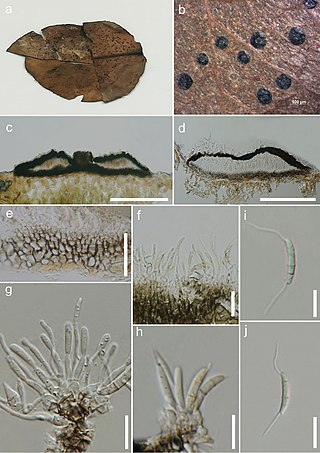Related Research Articles

The Pleosporales is the largest order in the fungal class Dothideomycetes. By a 2008 estimate, it contained 23 families, 332 genera and more than 4700 species. The majority of species are saprobes on decaying plant material in fresh water, marine, or terrestrial environments, but several species are also associated with living plants as parasites, epiphytes or endophytes. The best studied species cause plant diseases on important agricultural crops e.g. Cochliobolus heterostrophus, causing southern corn leaf blight on maize, Phaeosphaeria nodorum causing glume blotch on wheat and Leptosphaeria maculans causing a stem canker on cabbage crops (Brassica). Some species of Pleosporales occur on animal dung and a small number occur as lichens and rock-inhabiting fungi.

Pleosporaceae is a family of sac fungi. The taxonomic relationship of this family to associated genera is still not determined.
The Melanommataceae are a family of fungi in the order Pleosporales. Taxa are widespread in temperate and subtropical regions, and are saprobic on wood and bark.
The Phaeosphaeriaceae are a family of fungi in the order Pleosporales. Species in the family have a cosmopolitan distribution, and are generally nectrotrophic or saprobic on a wide range of plants.
The Didymosphaeriaceae are a family of fungi in the order Pleosporales. The family was erected by Anders Munk in 1953.
Nodulosphaeria is a genus of fungi in the family Phaeosphaeriaceae.

Phaeosphaeria is a genus of fungi in the family Phaeosphaeriaceae. It has about 95 species. The genus was circumscribed by Japanese mycologist Ichiro Miyake in 1909, with Phaeosphaeria oryzae assigned as the type species.
Capronia is a genus of fungi in the family Herpotrichiellaceae. It has about 80 species.
Broomella is a genus of fungi in the family Sporocadaceae.
Clathrospora is a genus of fungi in the family Diademaceae. The widespread genus contained five species in 2008, the genus increased to 20 species by 2023.
Comoclathris is a genus of fungi in the family Diademaceae.
Didymosphaeria is a genus of fungi in the family Didymosphaeriaceae.
Roussoëlla is a genus of fungi in the family Roussoellaceae. The genus is characterized by two-celled ascospores, unitunicate asci with a small spherical apical ring that stains slightly blue with Melzer's reagent, and stromata with several perithecia. The genus was circumscribed by Italian mycologist Pier Andrea Saccardo in 1888, with Roussoella nitidula assigned as the type species. The generic name honours Marietta Hannon Rousseau, (1850–1926), who was a Belgian mycologist and taxonomist.
Microthyrium is a genus of fungi in the Microthyriaceae family.
Lentithecium is a genus of fungi belonging to the family Lentitheciaceae.
Microsphaeropsis is a genus of fungi belonging to the family Didymosphaeriaceae.
Evan Benjamin Gareth Jones is a British mycologist. His main area of research interest is aquatic fungi, particularly marine fungi. He has supervised about 100 PhD and MSc students, published approximately 600 research articles and is a highly cited scientist. Other research interests include marine biofouling, biodeterioration of materials, and wood decay by fungi.
The Lentitheciaceae are a family of fungi in the order of Pleosporales. They are found world-wide with the greatest contributions found in Europe and Australia.

Discosia is a genus of plant pathogens in the family Sporocadaceae.
References
- ↑ "Keissleriella Höhn. 1919". MycoBank. International Mycological Association. Retrieved 2012-01-01.
- ↑ Lumbsch TH, Huhndorf SM. (December 2007). "Outline of Ascomycota – 2007". Myconet. Chicago, USA: The Field Museum, Department of Botany. 13: 1–58. Archived from the original on 2009-03-18.
- ↑ Wijayawardene, Nalin; Hyde, Kevin; Al-Ani, Laith Khalil Tawfeeq; Somayeh, Dolatabadi; Stadler, Marc; Haelewaters, Danny; et al. (2020). "Outline of Fungi and fungus-like taxa". Mycosphere. 11: 1060–1456. doi: 10.5943/mycosphere/11/1/8 .
- ↑ von Höhnel F. (1919). "Fragmente zur Mykologie. XXIII Mitteilung, Nr. 1154 bis 1188". Sitzungsberichte der Kaiserlichen Akademie der Wissenschaften, Math.-naturw. Klasse, Abt. I (in German). 128: 535–625.
- ↑ Burkhardt, Lotte (2022). Eine Enzyklopädie zu eponymischen Pflanzennamen [Encyclopedia of eponymic plant names](pdf) (in German). Berlin: Botanic Garden and Botanical Museum, Freie Universität Berlin. doi:10.3372/epolist2022. ISBN 978-3-946292-41-8 . Retrieved January 27, 2022.
- 1 2 "Species Fungorum - Search Page - Keissleriella". www.speciesfungorum.org. Retrieved 28 July 2023.